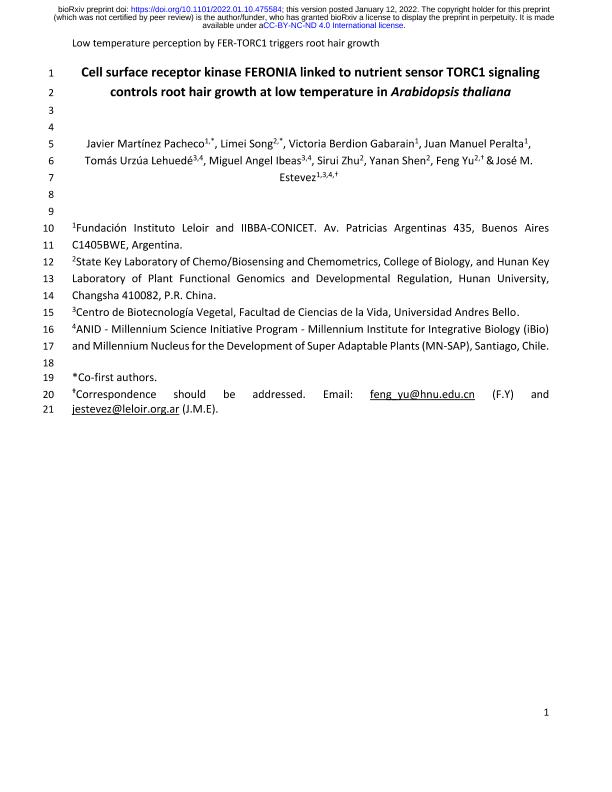Artículo
Cell surface receptor kinase FERONIA linked to nutrient sensor TORC1 signaling controls root hair growth at low temperature in Arabidopsis thaliana
Martinez Pacheco, Javier ; Song, Limei; Berdion Gabarain, Victoria
; Song, Limei; Berdion Gabarain, Victoria ; Peralta, Juan Manuel
; Peralta, Juan Manuel ; Urzúa Lehuedé, Tomás; Ibeas, Miguel Ángel; Zhu, Sirui; Shen, Yanan; Yu, Feng; Estevez, Jose Manuel
; Urzúa Lehuedé, Tomás; Ibeas, Miguel Ángel; Zhu, Sirui; Shen, Yanan; Yu, Feng; Estevez, Jose Manuel
 ; Song, Limei; Berdion Gabarain, Victoria
; Song, Limei; Berdion Gabarain, Victoria ; Peralta, Juan Manuel
; Peralta, Juan Manuel ; Urzúa Lehuedé, Tomás; Ibeas, Miguel Ángel; Zhu, Sirui; Shen, Yanan; Yu, Feng; Estevez, Jose Manuel
; Urzúa Lehuedé, Tomás; Ibeas, Miguel Ángel; Zhu, Sirui; Shen, Yanan; Yu, Feng; Estevez, Jose Manuel
Fecha de publicación:
01/2022
Editorial:
Cold Spring Harbor Laboratory Press
Revista:
BioRxiv
e-ISSN:
2692-8205
Idioma:
Inglés
Tipo de recurso:
Artículo publicado
Clasificación temática:
Resumen
Root hairs (RH) are excellent model systems for studying cell size regulation since they elongate several hundred-fold their original size. Their growth is determined both by intrinsic and environmental signals. Although nutrients availability in the soil are key factors for a sustained plant growth, the molecular mechanisms underlying their perception and downstream signaling pathways remains unclear. Here, we identified that a low temperature triggers a strong RH cell elongation response involving the cell surface receptor kinase FERONIA (FER) and nutrient sensor TORC1 pathway. We found that FER is required to perceive limited nutrients availability caused by low temperature, to interacts with and activate TORC1-downstream components to trigger RH growth. Nitrates perceived and transported by NRT1.1 were found to mimic this growth response at low temperature. Our findings reveal a new molecular mechanism by which a central hub composed by FER-TORC1 controls RH cell elongation under low temperature.
Palabras clave:
FERONIA
,
TORC1
,
ARABIDOPSIS THALIANA
,
COLD
,
NITRATES
Archivos asociados
Licencia
Identificadores
Colecciones
Articulos(IIBBA)
Articulos de INST.DE INVEST.BIOQUIMICAS DE BS.AS(I)
Articulos de INST.DE INVEST.BIOQUIMICAS DE BS.AS(I)
Citación
Martinez Pacheco, Javier; Song, Limei; Berdion Gabarain, Victoria; Peralta, Juan Manuel; Urzúa Lehuedé, Tomás; et al.; Cell surface receptor kinase FERONIA linked to nutrient sensor TORC1 signaling controls root hair growth at low temperature in Arabidopsis thaliana; Cold Spring Harbor Laboratory Press; BioRxiv; 2022; 1-2022; 1-29
Compartir
Altmétricas



